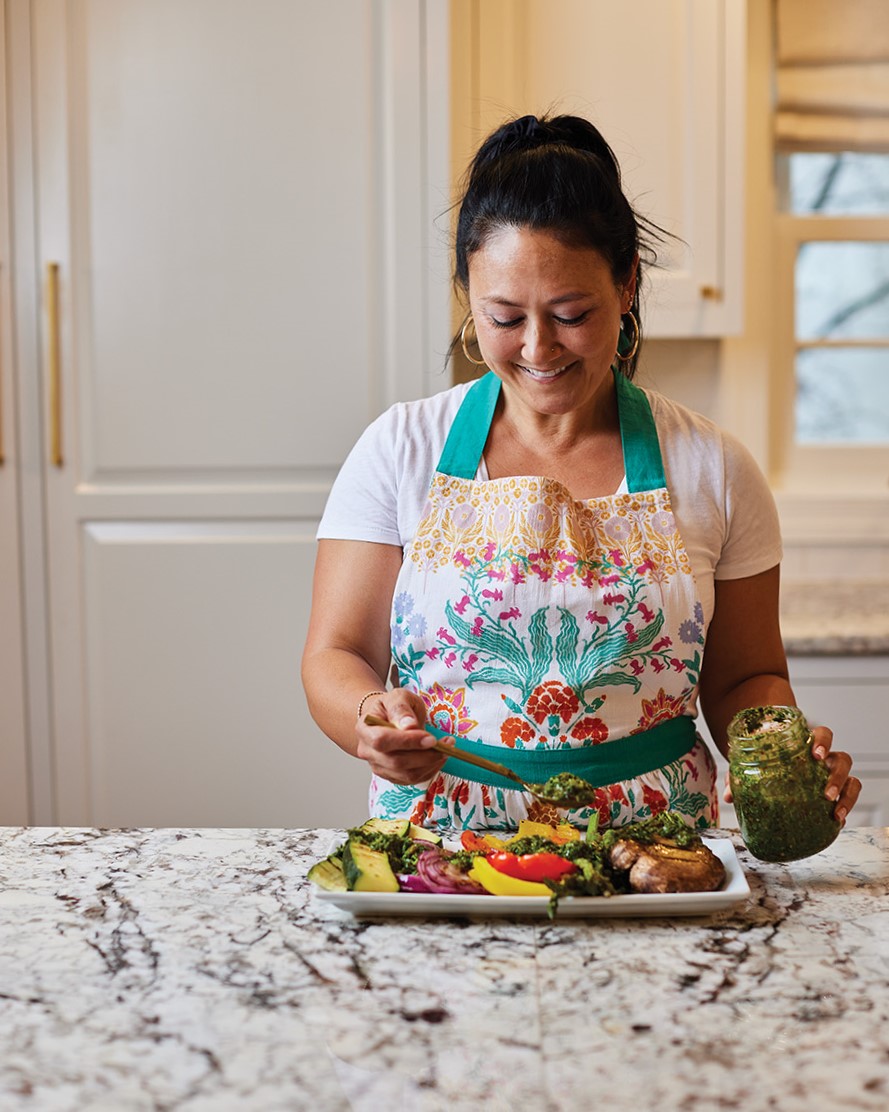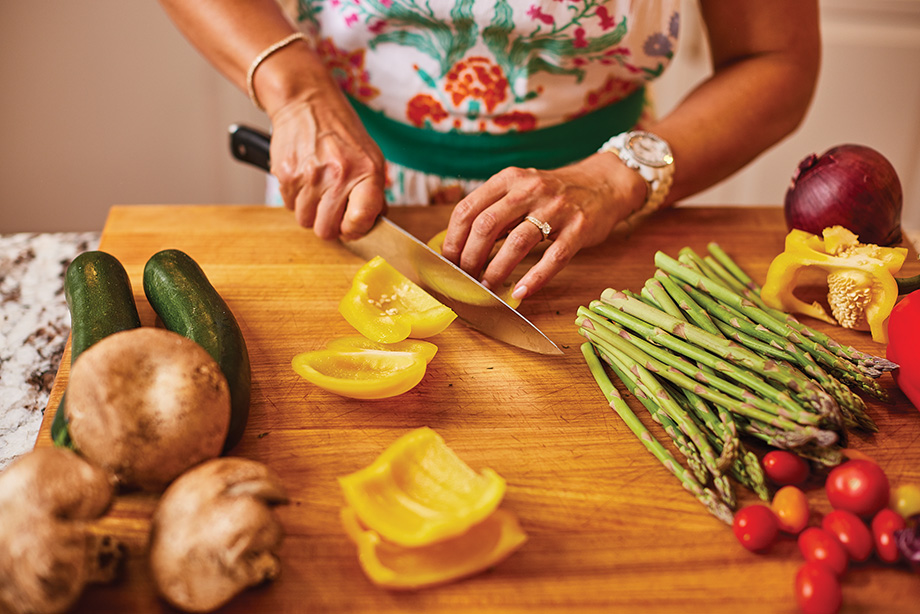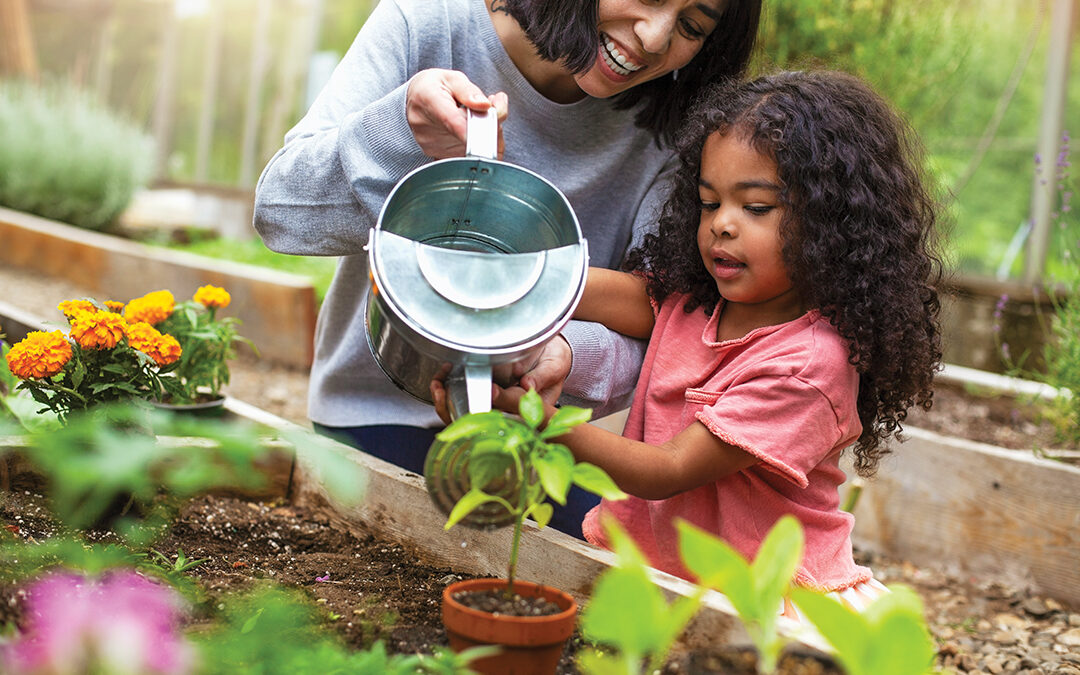
Photos: Chris Emeott
A journey toward better health became this resident’s teaching tool for empowering others.
“Health is made in the kitchen.” These are the words that nutritional therapy practitioner Amy Lippert lives by after dealing for nearly 10 years with Hashimoto’s thyroiditis, an autoimmune disorder affecting the thyroid gland. She says she’s a firm believer that food is medicine.
“I’ve been in the kitchen since I was 2. My mom is Korean. I remember sitting underneath the kitchen table in our home, and I had a bowl of garlic and warm water and my job was to peel the garlic. I’ve always loved being in the kitchen,” Lippert says.

Even though she thought she was living a healthy lifestyle, Lippert began suffering from a variety of symptoms in 2012, including fatigue, hair loss, joint inflammation, digestive dysfunction, anxiety and what she describes as “really bad brain fog.” Over the next five years, her symptoms got progressively worse.
In 2017, she went to her doctor at the time to discuss her symptoms, believing she may have Hashimoto’s; the doctor prescribed her an antianxiety medication to deal with her symptoms instead, which she says did little to lessen them. In 2018, she approached her doctor about performing a full thyroid panel. He refused and instead offered antidepressants, including Xanax. Lippert says she didn’t feel that her concerns were being taken seriously, so she started her search for another doctor.
“I live in my body; I know when something is wrong,” Lippert says.
Desiring a more holistic approach, she made an appointment with a functional medicine doctor who, after dissecting her thyroid peroxidase numbers a little more, diagnosed Lippert with Hashimoto’s thyroiditis, emboldening her to continue her pursuit toward better health.
In 2019, she enrolled in a 10-month holistic nutritional education program with the Nutritional Therapy Association (NTA). Initially, she wasn’t looking to become a practitioner herself; rather she was looking to apply the school’s functional holistic tools to her own lifestyle.
“I was still feeling really sick. I couldn’t wake up in the morning, [I was] wired at night [and had] brain fog to the point that my brain was having a hard time connecting the dots on things,” Lippert says.
By putting her nutrition education into practice—by adding more nutrient-dense whole foods to her diet and applying other holistic principles to her lifestyle—Lippert says her chronic symptoms significantly receded by September 2020.

“When you start to nourish your body, tune in and take care of yourself, hydrate [and] move, your body has the amazing ability to heal … When you start giving it what it needs, it takes off,” Lippert says.
After experiencing first-hand the changes in her body from these lifestyle changes, she decided to take her training from NTA and become a practitioner, starting to see clients in 2020.
Today, Lippert is a certified Nutritional Therapy Practitioner (NTP) and a curriculum manager and associate instructor for NTA. Lippert also has a bachelor’s of arts degree in chemistry, a bachelor’s of science degree in biology and a master’s degree in teaching in secondary education, a background that dovetails nicely with her current profession.
Through her practice, Lippert enjoys helping clients improve their health and wellness by addressing chronic symptoms, such as fatigue, digestive dysfunction, hormonal imbalances and more. She does this through optimizing digestion, sustainable lifestyle practices and targeted nutrition.
Lippert emphasizes that she doesn’t diagnose or treat disease. Rather, she uses nutrition and lifestyle changes to mitigate symptoms and get to the root cause of them. “You’re in the driver’s seat. I’m giving you routes to the destination, [but] you get to choose the path,” she says.

Through her consultation packages, Lippert creates individualized recommendations that will help clients add more nutrient-dense whole foods to their diet. But she tries not to take too many things away from them at once. And she advises clients to start small. “Small, sustainable changes are what will help you develop a new lifestyle,” Lippert says. “As you start to feel better, you’ll want to do more.”
One easy way Lippert incorporates more nutrient-dense whole foods into her own family’s diet is by buying food in its most natural state. For example, she’s more likely to purchase split chicken breasts, with the bones and skin still on it, instead of opting for boneless, skinless chicken. “When you cook it that way, you actually increase the nutrient density of that chicken because you’re cooking a lot of the minerals and a lot of the nutrients from the bones onto the meat and the fat from the skin,” Lippert says.
Lippert’s goal is to help clients create sustainable lifestyle habits, so that by the time they’re done working with her, they feel fully equipped to carry on their new habits without her help.

Eat for Your Health—And Enjoy It, Too
At the insistence of her friends and clients, Lippert started a food blog, Almond Milk and Cookies, in 2021. “I really got serious with it last summer. It’s a labor of love,” she says. “I like to share my recipes, and a nice side benefit is my kids will always have access to the things they grew up eating.”
Want to try some of Lippert’s tasty creations? She’s put together a full day’s menu.
Breakfast: Chocolate Banana Chia Pudding
“I love this because of how easy it comes together, the delicious creamy texture and ‘chunky monkey’ flavor. Plus, you can make several for the week in advance.”
Makes 4-6 Servings
- 2 cups plant milk*
- 2 Tbsp. unsalted sunflower seed butter
- 2 Tbsp. unsalted tahini
- ½ tsp. fine real salt
- 1 tsp. pure organic vanilla extract
- ½ cup pure maple syrup or pure raw honey
- ¼ cup organic chia seeds
- ½ cup Hu chocolate chips or 75% or higher dark chocolate**
- 1-2 scoops collagen protein powder (optional)
- 1 organic banana, diced
* Make this nut free by using hemp milk
**Substitute cacao nibs for Whole30
Add all of the ingredients except the chia seeds and banana to a high speed blender. Blend for 30-seconds on medium speed. Add the seeds and blend on high for 60-seconds. Pour the chia pudding into small mason jars or other containers and top with the chocolate chips. Refrigerate for 4-hours, up to overnight. Add sliced banana when ready to eat!
Lunch: Chicken Curry Stir-Fry
“I love this because it is loaded with great veggies and protein, and I love to add 1/4–1/2 of a fresh avocado for some good healthy fats. Plus, you can make a batch for lunches for the week.”
Serves 4-6
- 1 Tbsp. unrefined raw coconut oil
- 2 lbs. ground chicken
- ½ red onion, diced
- 2 cloves of garlic, finely minced
- 1-inch piece of fresh ginger, grated
- ¾ tsp. turmeric powder
- ½ tsp. ground coriander
- 1 tsp. smoked paprika
- 1 tsp. curry powder
- 1 tsp. ground cumin
- 1 tsp. fine sea salt or pink salt
- ½ tsp. ground black pepper
- 8-10 oz. coleslaw mix or shredded cabbage
- 6 oz. fresh baby spinach
In a skillet, add the coconut oil and ground chicken and brown over medium heat. Add the onions, garlic, fresh ginger, spices, salt and pepper. Stir and sauté for 5-7 minutes until the onions soften. Add the coleslaw mix or shredded cabbage and sauté another 2-3 minutes to soften. Add the baby spinach, stir and cook for another 1-2 minutes until softened. Enjoy!
Snack: Protein Breakfast Cookies
“I love to keep these on hand for quick and nutritious snacks. Paired with 1/2 cup of fresh berries, these are my son’s favorite after-school snack.”
Makes 22-24 Cookies
- 4-5 very ripe bananas
- 2 large pasture-raised eggs
- ¾ cup brown coconut sugar
- 2/3 cup unsweetened almond butter or peanut butter
- 1 tsp. pure vanilla extract
- 3 cups organic sprouted quick oats
- 1 cup peanut butter powder or protein powder of choice
- 1.5 tsp. ground cinnamon
- 1.5 tsp. baking soda
- 1 tsp. fine real salt*
- ½ cup raw pepitas (optional)
- ½ cup raw walnuts, chopped (optional)
- 1 cup dark chocolate chips (optional)
*Omit if your nut butter is salted
Preheat the oven to 350 degrees for convection, 375 degrees for conventional. In a large bowl, mash the bananas then add the eggs, almond or peanut butter, vanilla and coconut sugar, whisking to combine. In a medium bowl, combine the oats, peanut butter or protein powder, ground cinnamon, baking soda, pepitas, walnuts and chocolate chips, and stir with a fork to combine. Add the dry ingredients to the banana mixture and mix well until evenly mixed. Using a ¼ cup measuring cup to scoop out the protein cookie batter onto a baking sheet and gently flatten out into a level cookie. Bake for 12-14 minutes. Cool completely and enjoy!
Dinner: Grilled Veggies with Chimichurri and Perfect Grilled Flank Steak
“For the summer, there is nothing better than a juicy steak, grilled veggies and lots of herby chimichurri sauce.”

Grilled Veggies with Chimichurri
Makes 6-10 servings
Veggies
- 1 Red Bell Pepper
- 1 Yellow or Orange Bell Pepper
- 1 Yellow or Sweet Onion
- 1-2 Zucchini
- 1 bunch Asparagus
- 2-3 Portobello Mushroom Caps
- 2 Tbsp EVOO or Avocado Oil
- 1 tsp Fine Sea Salt or Pink Salt
- 1/2 tsp Ground Black Pepper
Authentic Mexican Chimichurri
- 1/2 red onion, large pieces
- 1-2 cloves garlic, peeled
- 1 bunch Italian parsley, thick stems removed
- 1 bunch cilantro, thick stems removed
- 2 Tbsp. red wine vinegar
- 1/2 tsp. crushed red pepper flakes
- 1/2 cup good EVOO
- 1 tsp. fine sea salt or pink salt
- 1/2 tsp. ground black pepper
Start by making the chimichurri sauce. Make it at least 1-hour before eating to allow for all those beautiful flavors to combine! In a food processor add the onion and garlic and process for 30-60 seconds until finely chopped. Add the fresh herbs, vinegar, salt and pepper, and red pepper flakes and pulse until fully combined (taking time to wipe down the bowl as needed). Add the EVOO and pulse the chimichurri a few times to incorporate. Transfer the chimichurri to a 16 ounce jar and add more EVOO if desired, stirring to mix and combine well. Set the chimichurri on the counter for an hour before serving to allow for the flavors to combine.
Preheat the grill to 425 degrees. Rinse and dry all the produce except the mushroom caps. Slice the bell peppers into 1.5-2-inch pieces. Slice the ends off the zucchini and slice lengthwise in half and then slice in half again making spears. Cut the stem end off of the onion and peel off the outer layer. Slice into ¼-inch rounds. Snap the ends off of the asparagus. Clean the dirt off the mushroom caps with a mushroom brush or a dry paper towel and slice into ¼-½-inch slices. Add all the veggies to a large dish or rimmed baking pan and drizzle over the EVOO or avocado oil and sprinkle with the sea salt and black pepper. Grill for 3-5 minutes per side, rotating once and grilling for another 3-5 minutes until the veggies are tender. Remove and replace back onto the large dish and top with homemade chimichurri sauce!
Perfect Grilled Flank Steak
Serves 3-5
- 1-1.25-lb. flank steak(s)
- 2 Tbsp. EVOO
- Sea salt or pink salt
- Fresh ground black pepper
One hour before grilling prepare the steak(s) by setting them out on a cutting board and coating with the EVOO. Rest for 30-45 minutes at room temperature. Preheat the grill to 500 degrees. Generously season with coarse sea salt and fresh ground black pepper on both sides. Grill the first side for 3-5 minutes, flip, grill second side for 3-5 minutes checking internal temp with a thermometer for your perfect steak temperature.* Rest 10-15 minutes and slice against the grain before serving.
*Internal Temperature Range
I usually pull the steak off about 3-5 degrees before the steak has reached its preferred temperature since it continues to rise a little during the resting phase.
- Rare – 120°F – 125°F
- Medium rare – 130°F – 135°F
- Medium – 140°F – 145°F
- Medium well – 150°F – 155°F
- Well done – 160°F
Dessert: Paleo Cheesecake with a Coconut Crust
“Hands down, my favorite dessert ever: blueberry cheesecake.”

Makes an 8-9 inch cheesecake
Paleo Cheesecake:
- 3 cups raw whole cashews, soaked*
- 1 cup coconut cream, cream only
- ½ cup unrefined coconut oil, melted
- 1 cup pure maple syrup
- 1 tsp. pure vanilla extract
- 1/3 cup fresh lemon zest (about 2 lemons)
- 5 oz. fresh lemon juice
- ½ tsp. fine real salt
*soak in hot water for 90-mins to 2-hours or overnight with cool water.
Paleo Coconut Pie Crust:
- 3/4 cup organic almond flour, packed
- ½ cup unsweetened shredded coconut
- 3/4 cup arrowroot starch or tapioca starch
- 1/2 cup brown coconut sugar
- 1/2 tsp. fine real salt
- 2 Tbsp. grass-fed beef gelatin powder
- 1/2 cup unrefined coconut oil or grass-fed ghee, melted
Paleo Blueberry Compote:
- 3.5-4 cups organic blueberries*
- 2 Tbsp. fresh lemon juice
- ¼ cup + 2 Tbsp. cool filtered water
- ½ cup organic coconut sugar
- 1 tsp. grass-fed beef gelatin
- ¼ tsp. fine real salt
- 1 tsp. pure vanilla extract
*Fresh or Frozen Blueberries
For the Paleo Coconut Pie Crust:
Preheat the oven to 325 degrees for convection or 350 degrees for conventional. Line an 8-9″ Springform pan with parchment on the bottom (I place this onto the bottom later and then attach the side piece). In a medium bowl, combine all the dry ingredients and mix well with a fork to combine. Pour in the coconut oil and mix well. Transfer to the parchment lined springform pan and evenly press into the bottom and about halfway up the sides. Bake for 12-minutes, cool completely.
For the Paleo Cheesecake Filling:
Add the cashews to a medium bowl and fill with water covering the cashews with 2″ of water. When the cashews are hydrated, drain in a mesh strainer and rinse under cool water. Set aside, in the mesh strainer and allow it to sit for 30-minutes. In a high speed blender, add all the cheesecake ingredients and blend on high until smooth and creamy, about 60-90 seconds. Pour over the prepared coconut crust and tightly cover with saran wrap. Cool completely in the refrigerator overnight.
For the Paleo Blueberry Compote:
In a small bowl, combine the lemon juice, 2 Tbsp. water and gelatin, and mix well to dissolve; set aside. In a medium saucepan, add the remaining ingredients and heat over low-med heat for 10-ish minutes until the blueberries have broken down and the sugar has dissolved. Stir in the lemon and gelatin mixture and bring the blueberries back to a low simmer for 1-2 minutes, ensuring all the gelatin has dissolved. Transfer to a clean jar and cool to room temperature before refrigerating. Refrigerate at least 2-hours before serving to allow blueberry compote to set.
Serve the chilled cheesecake with blueberry compote and enjoy!
Amy Lippert, NTP; naturalhealingfoodsnutrition.com
Almond Milk and Cookies
Facebook: Almond Milk and Cookies
Instagram: @almond.milk.and.cookies






















